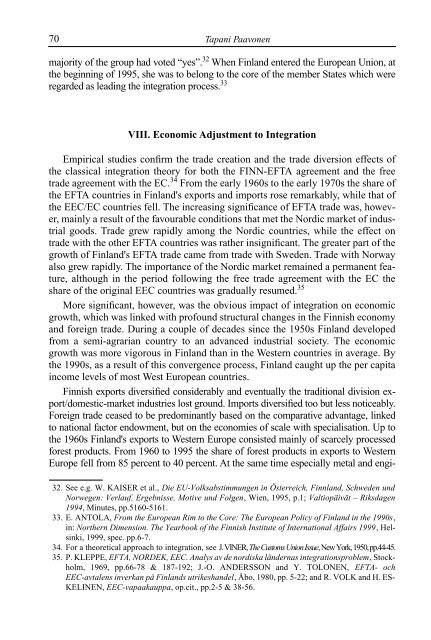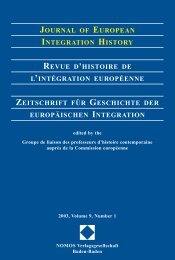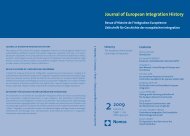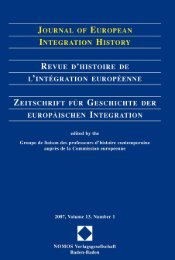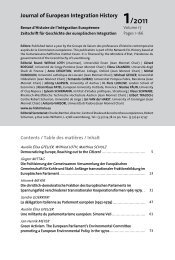journal of european integration history revue d'histoire de l ...
journal of european integration history revue d'histoire de l ...
journal of european integration history revue d'histoire de l ...
You also want an ePaper? Increase the reach of your titles
YUMPU automatically turns print PDFs into web optimized ePapers that Google loves.
70<br />
Tapani Paavonen<br />
majority <strong>of</strong> the group had voted “yes”. 32 When Finland entered the European Union, at<br />
the beginning <strong>of</strong> 1995, she was to belong to the core <strong>of</strong> the member States which were<br />
regar<strong>de</strong>d as leading the <strong>integration</strong> process. 33<br />
VIII. Economic Adjustment to Integration<br />
Empirical studies confirm the tra<strong>de</strong> creation and the tra<strong>de</strong> diversion effects <strong>of</strong><br />
the classical <strong>integration</strong> theory for both the FINN-EFTA agreement and the free<br />
tra<strong>de</strong> agreement with the EC. 34 From the early 1960s to the early 1970s the share <strong>of</strong><br />
the EFTA countries in Finland's exports and imports rose remarkably, while that <strong>of</strong><br />
the EEC/EC countries fell. The increasing significance <strong>of</strong> EFTA tra<strong>de</strong> was, however,<br />
mainly a result <strong>of</strong> the favourable conditions that met the Nordic market <strong>of</strong> industrial<br />
goods. Tra<strong>de</strong> grew rapidly among the Nordic countries, while the effect on<br />
tra<strong>de</strong> with the other EFTA countries was rather insignificant. The greater part <strong>of</strong> the<br />
growth <strong>of</strong> Finland's EFTA tra<strong>de</strong> came from tra<strong>de</strong> with Swe<strong>de</strong>n. Tra<strong>de</strong> with Norway<br />
also grew rapidly. The importance <strong>of</strong> the Nordic market remained a permanent feature,<br />
although in the period following the free tra<strong>de</strong> agreement with the EC the<br />
share <strong>of</strong> the original EEC countries was gradually resumed. 35<br />
More significant, however, was the obvious impact <strong>of</strong> <strong>integration</strong> on economic<br />
growth, which was linked with pr<strong>of</strong>ound structural changes in the Finnish economy<br />
and foreign tra<strong>de</strong>. During a couple <strong>of</strong> <strong>de</strong>ca<strong>de</strong>s since the 1950s Finland <strong>de</strong>veloped<br />
from a semi-agrarian country to an advanced industrial society. The economic<br />
growth was more vigorous in Finland than in the Western countries in average. By<br />
the 1990s, as a result <strong>of</strong> this convergence process, Finland caught up the per capita<br />
income levels <strong>of</strong> most West European countries.<br />
Finnish exports diversified consi<strong>de</strong>rably and eventually the traditional division export/domestic-market<br />
industries lost ground. Imports diversified too but less noticeably.<br />
Foreign tra<strong>de</strong> ceased to be predominantly based on the comparative advantage, linked<br />
to national factor endowment, but on the economies <strong>of</strong> scale with specialisation. Up to<br />
the 1960s Finland's exports to Western Europe consisted mainly <strong>of</strong> scarcely processed<br />
forest products. From 1960 to 1995 the share <strong>of</strong> forest products in exports to Western<br />
Europe fell from 85 percent to 40 percent. At the same time especially metal and engi-<br />
32. See e.g. W. KAISER et al., Die EU-Volksabstimmungen in Österreich, Finnland, Schwe<strong>de</strong>n und<br />
Norwegen: Verlauf, Ergebnisse, Motive und Folgen, Wien, 1995, p.1; Valtiopäivät – Riksdagen<br />
1994, Minutes, pp.5160-5161.<br />
33. E. ANTOLA, From the European Rim to the Core: The European Policy <strong>of</strong> Finland in the 1990s,<br />
in: Northern Dimension. The Yearbook <strong>of</strong> the Finnish Institute <strong>of</strong> International Affairs 1999, Helsinki,<br />
1999, spec. pp.6-7.<br />
34. For a theoretical approach to <strong>integration</strong>, see J. VINER, The Customs Union Issue, New York, 1950, pp.44-45.<br />
35. P. KLEPPE, EFTA, NORDEK, EEC. Analys av <strong>de</strong> nordiska län<strong>de</strong>rnas <strong>integration</strong>sproblem, Stockholm,<br />
1969, pp.66-78 & 187-192; J.-O. ANDERSSON and Y. TOLONEN, EFTA- och<br />
EEC-avtalens inverkan på Finlands utrikeshan<strong>de</strong>l, Åbo, 1980, pp. 5-22; and R. VOLK and H. ES-<br />
KELINEN, EEC-vapaakauppa, op.cit., pp.2-5 & 38-56.


